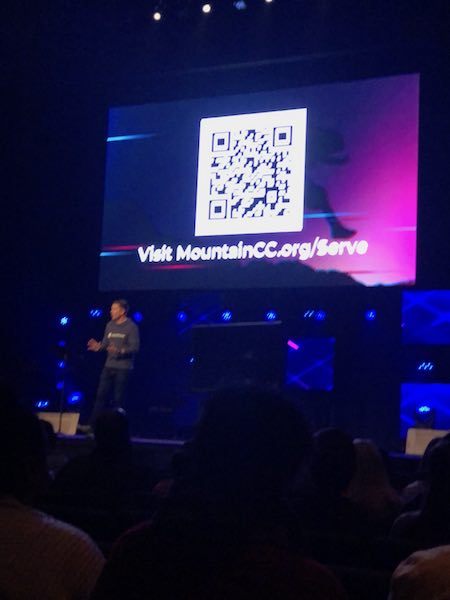Sorry, folks. But QR Codes may be on their way back. In a recent article, I gave two examples of where QR codes should have been and weren’t, and now I’m going to give two examples of where QR codes weren’t, but now they are and why.
The first example comes from an announcement made at our church, Mountain Christian. The pastor was sharing opportunities to serve, but instead of suggesting that people go to the website and click on the “serve” link to learn more, he did something new.
Behind him, on the giant projection screen, popped up a QR code that must have been 15 feet wide. But he didn’t say, “Scan this code to go to the serve page.” Instead, he did what my husband and I did last fall when we put the QR code on the exit survey for the Beachmont Corn Maze. He walked people through how to do it.

“I want you to do something for me,” he said. “Take out your phones. Yes, right now. OK, hold them up. Point them at the screen.” All around me, I saw phones going up. “That’s right! Just point your camera right there at the screen behind me.” It was a beautiful sight! In an auditorium of several thousand people, I saw cameras pointed upward. I don’t know how many people actually took to action on the page, but I do know that every one of them was exposed to the beauty and simplicity of QR codes—and that exposure was replicated at all five services at that campus that weekend.
I called the pastor responsible for this beautiful a strategy and asked where he got the idea and why now. He said that he had been encouraged at a ministry conference, especially with the QR code scanning capability now native in most phones today. He had also seen QR codes in action at a church in Kentucky where they were being used on the overhead TV monitor to make it easier for first-time visitors to fill out electronic connection cards.
“I always through QR codes were stupid because you had to download a reader,” he said. “Nobody is going to do that. But now that you just have to point the camera at the code and it connects automatically, it’s a game-changer.”
After the service, the pastor said the church saw an uptick—although not huge—to the page, and he will definitely use QR codes again. “Now that QR codes are part of the system, people will learn that it’s a thing,” he explained. “It will take awhile, but they will, and I’ll be encouraging others pastors to use them, too.”
Based on this conversation, I went back to my QR code nemesis, Ben, at Beachmont Christian Ministries. I wanted to know how many surveys completions were from QR code scans and how many were from the .bitly link. Unlike Mountain Christian Church, which sent people to a page on its regular website where it was impossible to tell where the traffic was coming from, Beachmont had sent people to a survey that was only accessible by QR code or .bitly link. That meant the QRC/.bitly split could be tracked.
Here’s what Ben told me:
|
|
Responses |
Percentage |
|
Total Survey Responses |
143 |
100% |
|
Responses from .bitly Link |
12 |
8% |
|
Responses from QR Code |
131 |
92% |
Of course, the high percentage of QR code usage can be directly attributed to my husband and I standing there, showing people how to do it. But the fact the .bitly link was so low shows that the ease of use mattered.
I asked Ben how he was feeling about QR codes now. He gave me a begrudging smile. “They’re coming back around.”
I asked if it was just Beachmont’s experience that caused him to say that or whether there had been other things he’d heard or experienced in-between then and now that changed his mind. He pointed to the elimination of the need for a separate app to scan QR codes (just like the pastor at Mountain), the fact that there seem to be more of QR codes around, and the fact that the user experience is improving.
“QR codes are being more widely adopted and people are becoming more accustomed to using them,” he said. “They also seem to be used more effectively in places that make sense. So the things you and I talked about initially—QR codes not being convenient and people having to go through multiple steps to use them—are gone. It’s a better overall user experience.”
Beachmont, in fact, is talking about adding learning centers around its campus, including in the corn maze (i.e., how corn is grown, how themed corn mazes are designed and created), and it is considering adding QR codes to the educational plaques to give the experiences more dimension. “It’s part of our effort to engage with the schools during maze season,” Ben said. “It just makes sense as an easy way to incorporate more information.”
Do the experiences of two nonprofits, in themselves, mean a resurgence in QR codes? Not on their own, no, but these are two independent perspectives and experiences that jive, and they jive for the same reasons. QR codes are easier to use, are being used more often, people are starting to become more familiar with them, and the user experience is improving.
Maybe businesses and organizations are finally on to something!















Discussion
By Maeghan Nicholson on May 27, 2020
We recently heard from some restaurants putting QR codes at the table to access "virtual menus" so there is nothing to hold and spread germs!
Discussion
Only verified members can comment.